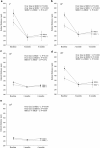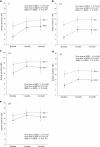Comparison of the efficacy of intravitreal triamcinolone acetonide for cystoid macular edema with versus without serous retinal detachment in branch retinal vein occlusion: influence on macular sensitivity and morphology
- PMID: 22876931
- PMCID: PMC3532084
- DOI: 10.1186/1471-2415-12-39
Comparison of the efficacy of intravitreal triamcinolone acetonide for cystoid macular edema with versus without serous retinal detachment in branch retinal vein occlusion: influence on macular sensitivity and morphology
Abstract
Background: The influence of serous retinal detachment (SRD) on visual acuity, macular sensitivity, and macular thickness is unclear after intravitreal injection of triamcinolone acetonide (IVTA) for macular edema with branch retinal vein occlusion (BRVO).
Methods: Twenty-one eyes of 21 BRVO patients with macular edema received IVTA. Patients were divided into two groups by optical coherence tomography findings: 11 patients who had cystoid macular edema (CME) with SRD (SRD (+) group) and 10 patients who had CME without SRD (SRD (-) group). Microperimetry was performed with a Micro Perimeter 1 before and at 3 and 6 months after IVTA. Macular thickness was measured by optical coherence tomography. We exchanged the superior and inferior regions to separate the regions into those with and without occlusion. As a result, the superior region was always the occluded region and the inferior region was non-occluded.
Results: In both the SRD (-) group and the SRD (+) group, the mean macular thickness within the central 4° field and the 10° and 20° fields of the occluded region decreased significantly from baseline to 3 and 6 months after IVTA (all P <0.01). Visual acuity also improved significantly in both groups from baseline to 3 and 6 months after IVTA (both P <0.05). In both groups, the mean macular sensitivity (measured with by microperimetry) within the central 4° field and the 10° and 20° fields of the occluded region showed a significant increase from baseline to 3 and 6 months after IVTA (all P <0.05). The trend profiles of macular thickness within the 10° and 20° fields of the occluded region showed significant differences, but there were no significant differences with respect to the trend profiles of visual acuity and macular sensitivity within the central 4° field and the 10° and 20° fields of the occluded region.
Conclusions: These results suggest that IVTA may achieve more marked improvement of macular morphology in BRVO patients with SRD than in those without SRD, while this therapy may have a similar effect on macular function in BRVO patients with or without SRD.
Figures



Similar articles
-
Visual function and serous retinal detachment in patients with branch retinal vein occlusion and macular edema: a case series.BMC Ophthalmol. 2011 Sep 26;11:29. doi: 10.1186/1471-2415-11-29. BMC Ophthalmol. 2011. PMID: 21943190 Free PMC article.
-
Retinal sensitivity improvement after intravitreal triamcinolone acetonide injection for macular edema secondary to branch retinal vein occlusion.Indian J Ophthalmol. 2013 Jan-Feb;61(1):3-7. doi: 10.4103/0301-4738.105048. Indian J Ophthalmol. 2013. PMID: 23275213 Free PMC article. Clinical Trial.
-
[Efficacy of early injection of intravitreal triamcinolone acetonide (IVTA) versus delayed injection for macular edema resulting from retinal vein occlusion].J Fr Ophtalmol. 2011 Jun;34(6):355-61. doi: 10.1016/j.jfo.2011.04.008. Epub 2011 Jun 8. J Fr Ophtalmol. 2011. PMID: 21652108 French.
-
Intravitreal Triamcinolone Acetonide for Diabetic Macular Edema and Macular Edema Secondary to Retinal Vein Occlusion: A Meta-Analysis.Ophthalmologica. 2024;247(1):19-29. doi: 10.1159/000533443. Epub 2023 Aug 14. Ophthalmologica. 2024. PMID: 37579730 Free PMC article.
-
Efficacy of different routes of triamcinolone acetonide administration on macular edema: A systematic review and network meta-analysis.PLoS One. 2025 Jan 24;20(1):e0317782. doi: 10.1371/journal.pone.0317782. eCollection 2025. PLoS One. 2025. PMID: 39854565 Free PMC article.
Cited by
-
Effect of intravitreal ranibizumab on serous retinal detachment in branch retinal vein occlusion.Clin Ophthalmol. 2018 Aug 17;12:1465-1470. doi: 10.2147/OPTH.S162019. eCollection 2018. Clin Ophthalmol. 2018. PMID: 30154642 Free PMC article.
-
Factors correlated with the resolution of macular oedema after one dose injection of intravitreal triamcinolone acetonide treatment in branch retinal vein occlusion.J Int Med Res. 2016 Jun;44(3):685-97. doi: 10.1177/0300060515617386. Epub 2016 Mar 1. J Int Med Res. 2016. PMID: 26936966 Free PMC article.
-
A systematic review of real-world evidence of the management of macular oedema secondary to branch retinal vein occlusion.Eye (Lond). 2020 Oct;34(10):1770-1796. doi: 10.1038/s41433-020-0861-9. Epub 2020 Apr 20. Eye (Lond). 2020. PMID: 32313172 Free PMC article.
-
Biochemical and microstructural determinants of the development of serous retinal detachment secondary to retinal vein occlusion.Heliyon. 2023 Dec 16;10(1):e23716. doi: 10.1016/j.heliyon.2023.e23716. eCollection 2024 Jan 15. Heliyon. 2023. PMID: 38187225 Free PMC article.
-
Treatment strategy for BVO-ME based on long-term outcomes correlating retinal structure by OCT image and visual acuity.BMC Ophthalmol. 2023 Sep 20;23(1):385. doi: 10.1186/s12886-023-03138-2. BMC Ophthalmol. 2023. PMID: 37726720 Free PMC article.
References
-
- Michels RG, Gass JD. The natural course of retinal branch vein obstruction. Trans Am Acad Ophthalmol Otolaryngol. 1974;78:166–177. - PubMed
-
- Gutman FA, Zegarra H. The natural course of temporal retinal branch vein occlusion. Trans Am Acad Ophthalmol Otolaryngol. 1974;78:178–192. - PubMed
-
- Noma H, Funatsu H, Sakata K, Harino S, Nagaoka T, Mimura T, Sone T, Hori S. Macular microcirculation and macular oedema in branch retinal vein occlusion. Br J Ophthalmol. 2009;93:630–633. - PubMed
-
- Scott IU, Ip MS, VanVeldhuisen PC, Oden NL, Blodi BA, Fisher M, Chan CK, Gonzalez VH, Singerman LJ, Tolentino M. A randomized trial comparing the efficacy and safety of intravitreal triamcinolone with standard care to treat vision loss associated with macular Edema secondary to branch retinal vein occlusion: the Standard Care vs Corticosteroid for Retinal Vein Occlusion (SCORE) study report 6. Arch Ophthalmol. 2009;127:1115–1128. - PMC - PubMed
-
- Brown DM, Campochiaro PA, Bhisitkul RB, Ho AC, Gray S, Saroj N, Adamis AP, Rubio RG, Murahashi WY. Sustained Benefits from Ranibizumab for Macular Edema Following Branch Retinal Vein Occlusion: 12-Month Outcomes of a Phase III Study. Ophthalmology. 2011;118:1594–1602. - PubMed
Publication types
MeSH terms
Substances
LinkOut - more resources
Full Text Sources
Medical
Research Materials

